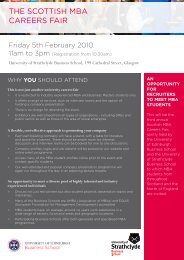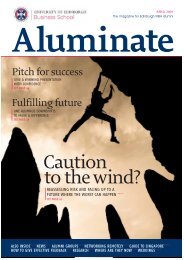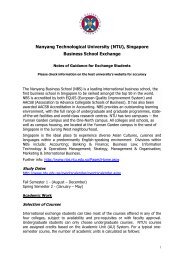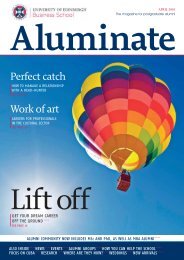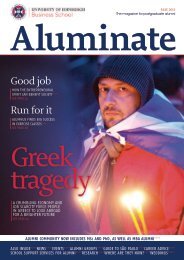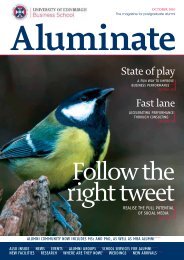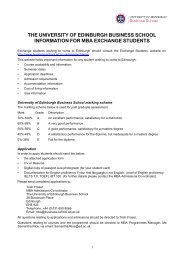killed Saab Automobile? - Business School - University of Edinburgh
killed Saab Automobile? - Business School - University of Edinburgh
killed Saab Automobile? - Business School - University of Edinburgh
Create successful ePaper yourself
Turn your PDF publications into a flip-book with our unique Google optimized e-Paper software.
Was GM the right partner?<br />
GM was <strong>Saab</strong>'s owner, in whole or in part, for almost 20 years. So why could GM not make it work?<br />
After all, as the largest car manufacturer in the world for most <strong>of</strong> that time GM had both the financial<br />
resources and knowledge necessary for success in the automotive industry. Was GM the real culprit in<br />
<strong>Saab</strong>'s demise?<br />
Many observers have argued <strong>Saab</strong>’s decline was a consequence <strong>of</strong> brand mismanagement by GM.<br />
Our view is that this is too simplistic. To GM’s credit, it supported <strong>Saab</strong>, despite <strong>Saab</strong>’s losses, in<br />
almost every year <strong>of</strong> its 20 year ownership <strong>of</strong> <strong>Saab</strong> (with the exception <strong>of</strong> 1994, 1995 and 2001). But<br />
GM’s configuration in Europe as a very high-volume producer <strong>of</strong> economy to mid range cars sat<br />
uncomfortably with <strong>Saab</strong>’s niche <strong>of</strong> individualism, technological sophistication and premium positioning.<br />
<strong>Saab</strong> for its part resisted necessary attempts by GM to standardize and cut costs by sharing technology<br />
with its Opel and Vauxhall models.<br />
So although GM has been accused <strong>of</strong> failing to understand <strong>Saab</strong>'s brand it had little choice but to try to<br />
integrate <strong>Saab</strong> into GM Europe. <strong>Saab</strong> however felt that GM's interference was counter-productive to its<br />
success, and stubbornly resisted attempts to move it towards such integration. There was palpable<br />
friction because these two firms were simply very different.<br />
Critical to the success <strong>of</strong> an alliance or merger between two car companies is the scope for synergy by<br />
pooling resources, sharing knowledge, and economies <strong>of</strong> scale. In the absence <strong>of</strong> these, there can be<br />
little hope <strong>of</strong> long term success. More likely than not, the weaker partner, generally the acquired firm,<br />
will keep losing money, and eventually the parent will discard the loss-making subsidiary as happened<br />
with GM and <strong>Saab</strong>, BMW and Rover and Ford and Jaguar-Land Rover.<br />
A key element in successful automotive mergers is ‘complementarity’, that is, where both firms gain<br />
something from the partnership. This can come in many forms: access to technology, access to capital<br />
for investment, lower cost by sharing platforms and components, but also non-production synergies,<br />
such as access to new markets.<br />
The Volkswagen Group is an example <strong>of</strong> a firm that has executed this strategy very well. Within the<br />
Group there is extensive sharing <strong>of</strong> platforms, powertrains and parts across brands in the Group (Audi,<br />
Seat, Skoda and VW) whilst allowing each brand an identity appropriate to its particular market. This<br />
creates economies <strong>of</strong> scale and means that lower volume models can be <strong>of</strong>fered at a pr<strong>of</strong>it (or to put it<br />
another way, that diversity <strong>of</strong> models can be <strong>of</strong>fered without a major cost penalty).<br />
A less obvious example is Renault-Nissan. In 1999 Nissan was burdened with debt and almost<br />
bankrupt and merged with Renault. At first glance these two firms had little in common and at the time<br />
analysts were sceptical that the merger would work out. As it has turned out Renault and Nissan had<br />
strongly complementary capabilities, market presence and compatible product architecture, as shown<br />
in the table below. Being different in some respects but compatible in others is clearly important (see<br />
Table 1 for an overview).<br />
An example <strong>of</strong> a failed merger is the DaimlerChrysler tie-up, which lasted from 1998-2007. Here both<br />
firms had rather similar regional coverage, both having a strong presence in the US, both being weak in<br />
emerging markets. They employed very different product architectures (front wheel-drive at Chrysler<br />
and rear-wheel drive at Mercedes, so only a single vehicle was ever shared between the two firms: the<br />
‘Crossfire’, a rebadged Mercedes SLK). The two firms had radically different brand identities and<br />
market positioning.<br />
24





